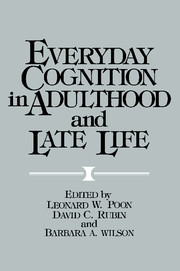Book contents
- Frontmatter
- Contents
- List of contributors
- Preface
- Part I Adult cognitive abilities in the laboratory and in real-life settings: Basic theoretical and methodological issues
- Part IA Systematic approaches to laboratory and real-world research
- Part IB Combining laboratory and real-world research
- Part II Cognition in adulthood and late life: Findings in real-life settings
- Part IIA Everyday cognitive abilities
- 11 Memory for prose: Perspectives on the reader
- 12 Prose processing in adulthood: The text, the reader, and the task
- 13 Speech comprehension and memory through adulthood: The roles of time and strategy
- 14 The effects of aging on perceived and generated memories
- 15 Aging and word retrieval: Naturalistic, clinical, and laboratory data
- 16 Acquisition and utilization of spatial information by elderly adults: Implications for day-to-day situations
- 17 Inner-city decay? Age changes in structure and process in recall of familiar topographical information
- 18 The cognitive ecology of problem solving
- 19 Everyday problem solving: Methodological issues, research findings, and a model
- 20 Prospective/intentional memory and aging: Memory as adaptive action
- Part IIB Concomitant influences
- Part III Cognitive enhancement and aging: Clinical and educational applications
- Part IIIA Issues and perspectives
- Part IIIB Enhancement approaches
- Part IIIC Designing programs for cognitive rehabilitation
- Subject index
- Author index
12 - Prose processing in adulthood: The text, the reader, and the task
Published online by Cambridge University Press: 05 October 2013
- Frontmatter
- Contents
- List of contributors
- Preface
- Part I Adult cognitive abilities in the laboratory and in real-life settings: Basic theoretical and methodological issues
- Part IA Systematic approaches to laboratory and real-world research
- Part IB Combining laboratory and real-world research
- Part II Cognition in adulthood and late life: Findings in real-life settings
- Part IIA Everyday cognitive abilities
- 11 Memory for prose: Perspectives on the reader
- 12 Prose processing in adulthood: The text, the reader, and the task
- 13 Speech comprehension and memory through adulthood: The roles of time and strategy
- 14 The effects of aging on perceived and generated memories
- 15 Aging and word retrieval: Naturalistic, clinical, and laboratory data
- 16 Acquisition and utilization of spatial information by elderly adults: Implications for day-to-day situations
- 17 Inner-city decay? Age changes in structure and process in recall of familiar topographical information
- 18 The cognitive ecology of problem solving
- 19 Everyday problem solving: Methodological issues, research findings, and a model
- 20 Prospective/intentional memory and aging: Memory as adaptive action
- Part IIB Concomitant influences
- Part III Cognitive enhancement and aging: Clinical and educational applications
- Part IIIA Issues and perspectives
- Part IIIB Enhancement approaches
- Part IIIC Designing programs for cognitive rehabilitation
- Subject index
- Author index
Summary
During the last five years, a substantial increase has occurred in the number of studies investigating aging effects in processing prose. As noted by Hartley in Chapter 11, many recent studies have reported age-related differences in quantity and quality of recall, whereas others have found no differences. In attempts to understand these discrepancies, analyses of this literature (Hultsch & Dixon, 1984; Meyer & Rice, 1983a) have been cast in terms of an interactional scheme among text, learner, and task variables (Figure 12.1). Because these variables interact in the comprehension process, it is impossible to discuss them adequately in isolation. However, this chapter emphasizes text variables, whereas Chapter 11 emphasized learner variables. Before examining text variables, we shall discuss learner and task variables, because their consideration is critical in understanding discrepancies in the literature on aging and prose learning.
Learner variables
Education and vocabulary
In considering the learner variables of education and vocabulary as partially responsible for the contradictory aging effects in prose learning, we are considering the long-standing problem in aging research of how to make old and younger age groups equivalent on cultural variables in cross-sectional studies (Birren & Morrison, 1961; Botwinick, 1978; Krauss, 1980). If studies examine only old adults with college degrees, their findings may not hold for the majority of old adults, who lack these degrees. In addition, degrees from various institutions and generations differ in educational value.
- Type
- Chapter
- Information
- Everyday Cognition in Adulthood and Late Life , pp. 157 - 194Publisher: Cambridge University PressPrint publication year: 1989
- 39
- Cited by



